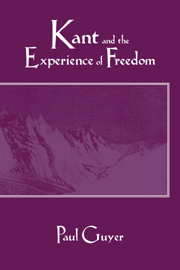Book contents
- Frontmatter
- Contents
- Preface
- Note on citations
- Introduction
- KANT'S AESTHETICS IN HISTORICAL CONTEXT
- Chapter 1 Feeling and freedom: Kant on aesthetics and morality
- Chapter 2 The dialectic of disinterestedness: I. Eighteenth-century aesthetics
- Chapter 3 The dialectic of disinterestedness: II. Kant and Schiller on interest in disinterestedness
- Chapter 4 The perfections of art: Mendelssohn, Moritz, and Kant
- Chapter 5 Hegel on Kant's aesthetics: necessity and contingency in beauty and art
- KANT'S AESTHETICS AND MORALITY: TOPICAL STUDIES
- Notes
- Bibliography
- Index
Chapter 2 - The dialectic of disinterestedness: I. Eighteenth-century aesthetics
Published online by Cambridge University Press: 05 March 2012
- Frontmatter
- Contents
- Preface
- Note on citations
- Introduction
- KANT'S AESTHETICS IN HISTORICAL CONTEXT
- Chapter 1 Feeling and freedom: Kant on aesthetics and morality
- Chapter 2 The dialectic of disinterestedness: I. Eighteenth-century aesthetics
- Chapter 3 The dialectic of disinterestedness: II. Kant and Schiller on interest in disinterestedness
- Chapter 4 The perfections of art: Mendelssohn, Moritz, and Kant
- Chapter 5 Hegel on Kant's aesthetics: necessity and contingency in beauty and art
- KANT'S AESTHETICS AND MORALITY: TOPICAL STUDIES
- Notes
- Bibliography
- Index
Summary
According to standard histories of eighteenth-century aesthetics, Anthony Ashley Cooper, third earl of Shaftesbury, and, under his influence, Francis Hutcheson, professor of moral philosophy at Glasgow, characterized our response to objects displaying beauty and other aesthetic properties such as grandeur or sublimity as “disinterested,” or independent of our normal theoretical and practical interests. This characterization of what we now call “aesthetic experience” is supposed to have been accepted by the many writers on aesthetics who followed them, until Kant formalized the theory by elevating disinterestedness into the first criterial “moment” and the premise of all his further analysis of the judgment of taste. Following Kant, writers such as Schopenhauer made disinterestedness the fundamental hallmark of the aesthetic, a position which it retained in Romantic and Idealist conceptions of the “autonomy” of art and in their progeny, the conceptions of “distance” or “detachment” in analytical aesthetics as an “aesthetic attitude” necessary to allow the genuine “aesthetic properties” of “aesthetic objects” to be observed and properly enjoyed.
This little story drastically simplifies a much more complicated history. Shaftesbury did indeed introduce two themes that were to remain constant through the remainder of the eighteenth century and influence aesthetic theory well into our own. These are, first, the idea that our response to a beautiful object is a natural and immediate response that is more like a sensory reaction than a protracted reflection or ratiocination; and, second, the view that this response transpires independently of any reflection on the personal or private interest or advantage of the agent enjoying it.
- Type
- Chapter
- Information
- Kant and the Experience of FreedomEssays on Aesthetics and Morality, pp. 48 - 93Publisher: Cambridge University PressPrint publication year: 1993
- 1
- Cited by

